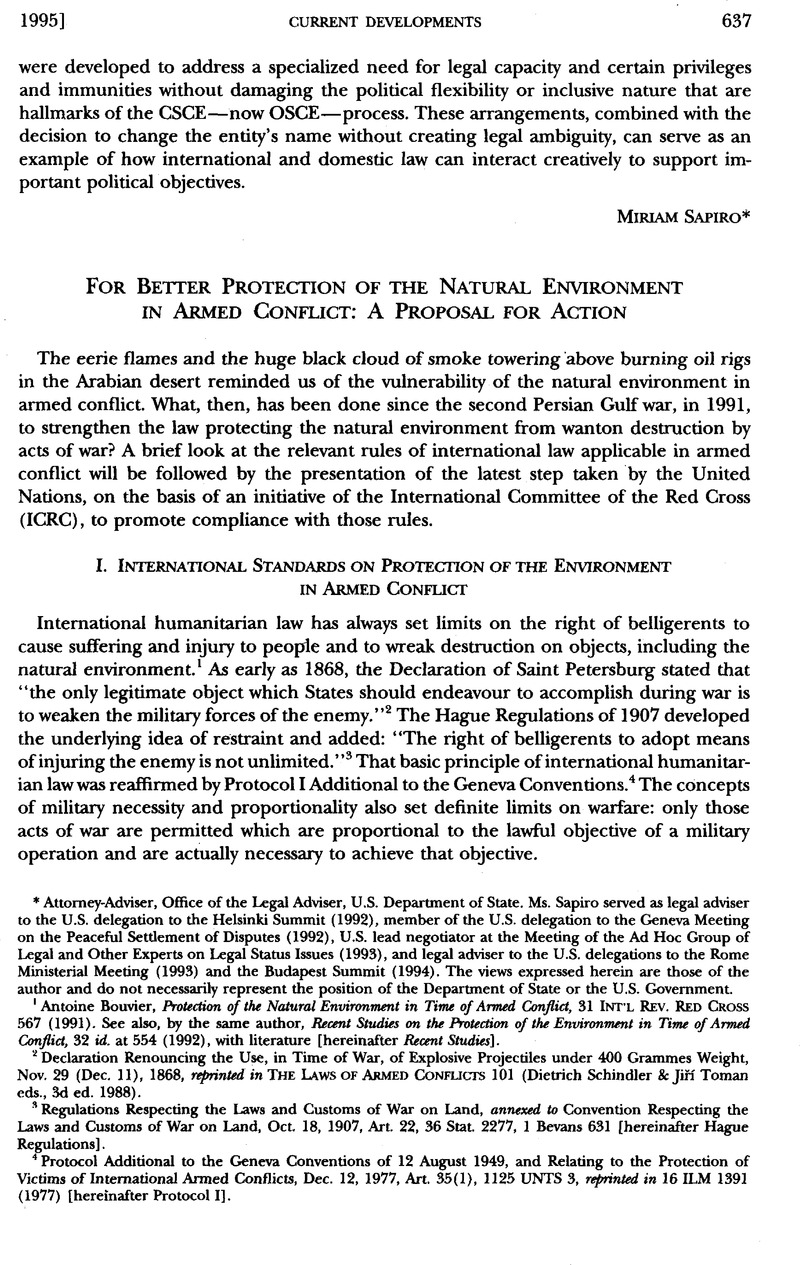Published online by Cambridge University Press: 27 February 2017

* Attorney-Adviser, Office of the Legal Adviser, U.S. Department of State. Ms. Sapiro served as legal adviser to the U.S. delegation to the Helsinki Summit (1992), member of the U.S. delegation to the Geneva Meeting on the Peaceful Settlement of Disputes (1992), U.S. lead negotiator at the Meeting of the Ad Hoc Group of Legal and Other Experts on Legal Status Issues (1993), and legal adviser to the U.S. delegations to the Rome Ministerial Meeting (1993) and the Budapest Summit (1994). The views expressed herein are those of the author and do not necessarily represent the position of the Department of State or the U.S. Government.
1 Antoine Bouvier, Protection of the Natural Environment in Time of Armed Conflict, 31 Int’l Rev. Red Cross 567 (1991). See also, by the same author, Recent Studies on the Protection of the Environment in Time of Armed Conflict, 32 id. at 554 (1992), with literature [hereinafter Recent Studies].
2 Declaration Renouncing the Use, in Time of War, of Explosive Projectiles under 400 Grammes Weight, Nov. 29 (Dec. 11), 1868, reprinted in The Laws of Armed Conflicts 101 (Dietrich Schindler & Jiří Toman eds., 3d ed. 1988).
3 Regulations Respecting the Laws and Customs of War on Land, annexed to Convention Respecting the Laws and Customs of War on Land, Oct. 18, 1907, Art. 22, 36 Stat. 2277, 1 Bevans 631 [hereinafter Hague Regulations].
4 Protocol Additional to the Geneva Conventions of 12 August 1949, and Relating to the Protection of Victims of International Armed Conflicts, Dec. 12, 1977, Art. 35(1), 1125 UNTS 3, reprinted in 16 ILM 1391 (1977) [hereinafter Protocol I].
5 Hague Regulations, supra note 3, Art. 23(g).
6 Geneva Convention Relative to the Protection of Civilian Persons in Time of War, Aug. 12, 1949, Art. 53, 6 UST 3516, 75 UNTS 287.
7 Protocol I, supra note 4, Art. 35(3).
8 Convention on Prohibitions or. Restrictions on the Use of Certain Conventional Weapons Which May Be Deemed to Be Excessively Injurious or to Have Indiscriminate Effects, opened for signature Apr. 10, 1981, reprinted in 19 ILM 1524 (1980). On March 24, 1995, the United States ratified the Convention and Protocols I and II. Protocol I deals with nondetectable fragments.
9 Convention on the Prohibition of Military and Other Hostile Use of Environmental Modification Techniques, opened for signature May 18, 1977, 1108 UNTS 151, reprinted in 16 ILM 88 (1977). On the (meagre) results of the second Review Conference (Geneva, September 1992), see Bouvier, Recent Studies, supra note 1, at 561–64.
10 UNEP, Governing Council, 16th Sess., Resolution 16/11 on Military Conflicts and the Environment (May 31, 1991), reprinted in UN Doc. A/46/25 (1991).
11 Rio Declaration on Environment and Development, UN Doc. A/CONF.151/5/Rev.1, reprinted in 31 ILM 874 (1992). See also Bouvier, Recent Studies, supra note 1, at 558–61.
12 See Glen Plant, Environmental Protection and the Law of War: A ‘Fifth Geneva’ Convention on the Protection of the Environment in Time of Armed Conflict (1992).
13 Ministry of External Affairs, Conference of Experts on the Use of the Environment as a Tool of Conventional Warfare, Ottawa, 9–12 July 1991, Chairman’s Conclusions (unpublished, on file with author).
14 International Council of Environmental Law and IUCN-Commission on Environmental Law, Law Concerning the Protection of the Environment in Times of Armed Conflict, Consultation, 13–15 December 1991, Final Recommendations (unpublished, on file with author).
15 Implementation of international humanitarian law, Protection of the civilian population and persons hors de combat, Twenty-sixth International Conference of the Red Cross and Red Crescent, Doc. C.I/4.2/1, at 15 (1991).
16 The 26th conference was postponed and is to take place in December 1995 in Geneva.
17 GA Decision 46/417 (Dec. 9, 1991).
18 ICRC, Meeting of experts on the protection of the environment in time of armed conflict, Report on the work of the meeting (Sept. 1992) (unpublished). See Bouvier, Recent Studies, supra note 1, at 556–58.
19 UN Doc. A/47/328 (1992). See Bouvier, Recent Studies, supra note 1, at 564–65.
20 GA Res. 47/37 (Nov. 25, 1992).
21 ICRC, Second Meeting of experts on the protection of the environment in time of armed conflict, Report on the work of the meeting (Apr. 1993) (unpublished).
22 UN Doc. A/48/269, ch. II (1993). The discussion on the protection of the environment in time of armed conflict was incorporated into the agenda item “United Nations Decade of International Law.”
23 GA Res. 48/30 (Dec. 9, 1993).
24 UN Doc. A/49/323 (1994), in particular its Annex: Guidelines for military manuals and instructions on the protection of the environment in times of armed conflict, which is reprinted as an appendix to this Note, infra.
25 GA Res. 49/50 (Dec. 9, 1994).
26 See supra note 24.
27 UN Doc. A/49/323, supra note 24, at 49–53.